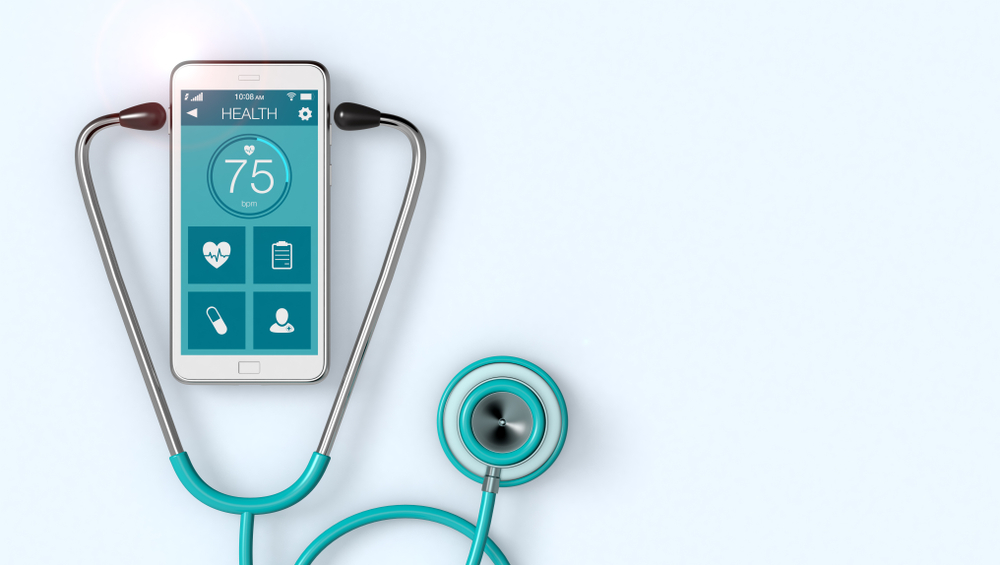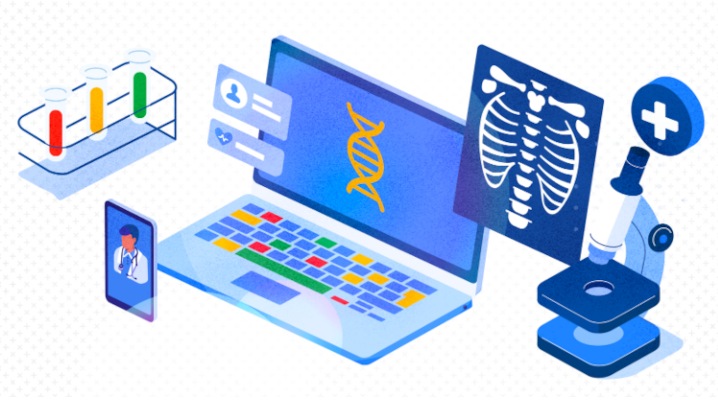The global pandemic pushed the sector to adapt and innovate. It defined, too, how healthcare will change in the next 10 years.
This does not mean the industry has moved substantially from the path that it was on. Digital technologies were already having an impact on healthcare, but the investment in change wasn’t hurried. Now investment is an expedited change.
2023 will see similar technology trends in healthcare, as well as adoption of new technologies, though most of it will be the ripple effect of the changes that happened in 2020. Read on to find our detailed analysis of the most significant healthtech technology trends for this year to stay ahead of the market.
Healthcare Technology: Market Overview

In what is now a familiar story, the healthcare systems, overwhelmed by COVID-19 patients, relied heavily on technology to become more efficient. This meant streamlining in-patient care, relying on remote technologies, using big data analytics to make decisions, and even accepting the risks of weak cybersecurity measures.
One big indicator of this is how IT teams have become part and parcel of hospital operations. From cybersecurity to AI applications, technology companies are developing more and more solutions for healthcare clients. The use of data interoperability, artificial intelligence (AI), and machine learning (ML) have been particularly impressive.
Read also: Use Cases of Machine Learning in the Medical Field
The healthcare technology market trends reflects this increase in investment and the urgent need for advanced digital solutions. According to CB Insights, global healthcare funding hit a new record in 2020. There were over 5,500 deals that amounted to a total of $80.6 billion raised as equity funding. There were a record 187 healthcare mega-rounds ($100M+) as well.
Funding for digital health companies touched $26.5 billion in 2020, an all-time high. On-demand healthcare was the most funded “value proposition” in 2020. The market is betting that healthcare technology can unlock great value and significantly impact digital health trends in 2022.
On-Demand Economy: How Does It Relate to Healthcare Trends?

Technology companies created the “on-demand economy” to meet the consumer request for goods and services. Obviously, this business model is driven by developments in connectivity and personal devices. It’s also referred to as “access economy” or “shared economy.”
This also changed the way jobs were seen in two ways. One, it created an independent workforce that met the lack of talent in many on-demand services. A good example would be Uber drivers. Two, staffing itself came to be seen as an on-demand service. More and more people were comfortable taking on “gigs” and then moving on. This offered high-skilled workers an alternative to full-time employment.
The on-demand economy has grown over the past decade. Uber was founded in early 2009, and there’s been an explosion of on-demand services since then. The Harvard Business Review reports that there were about 150 million “independent contractors” in North America and Western Europe in 2018. A SunTrust survey found that 81% of Americans would like to convert their “side gig” into a career. Over 50% of those surveyed had taken up a freelance job to earn extra money.
Demigos experience
Of course, the innovations seen in the on-demand economy impacted the healthcare sector as well. From tackling the shortage of talent to finding new ways to engage with patients and healthcare payers, digital solutions like the US-based Wendy’s, for example, make sense for the healthcare sector. This particular digital on-demand service connects caregivers to seniors at the click of a button.
Staffing Issues in Healthcare
The COVID-19 pandemic exposed quite a few weaknesses in the global healthcare system, with staffing a major problem in many parts of the world. Staffing issues will extend beyond the pandemic, though: the World Health Organization estimates there would be a shortage of 9.9 million healthcare workers globally by 2030.
The United States, for instance, will need to hire 2.3 million new healthcare workers by 2025 to take care of its aging population, according to a report compiled by the global healthcare staffing consultancy Mercer.
Under such circumstances, it’s not surprising that healthcare job postings remain open for months or even years. This is especially true for rural areas, even in North America and Europe. The concept of “travel nursing” has become more common in the US with fewer nurses available.
Demigos experience
The result is healthcare facilities that have been unable to find enough doctors and nurses to meet crisis requirements. While the current global pandemic might be extraordinary, it’s just as much an issue during seasonal outbreaks. A good example would be peak influenza season. Apart from doctors and nurses, there aren’t enough clinicians, lab workers, and technicians in many countries. A great example of a tech solution to the problems like these is GapNurse, a web-based staffing platform for healthcare providers we developed.
Telemedicine
Telemedicine would represent the simplest form of an on-demand service in the list of healthcare technology trends. Not every patient needs to go to an emergency room or a hospital to consult with a doctor, and a teleconsultation could be the most appropriate alternative.
It might seem like a nice-to-have option, but in the context of 2020, it suddenly turned into a must. In the early days of the pandemic restrictions, patients with chronic health issues—diabetes, hypertension, high cholesterol, and so on—had to stay away from hospitals. This delayed the care they needed, the care that could have been provided through telemedicine adoption and connected medical devices.
Regulations and Risks
The on-demand economy is a tricky subject when it comes to regulations. Most recently, the UK’s Supreme Court ruled that Uber drivers were not “self-employed” and were to be considered Uber employees. That means they’re entitled to benefits like minimum wage and holiday pay, which adds a huge wage bill to Uber’s expenses.
The European Union is also struggling to draft clear regulations to oversee the on-demand economy. The European Agency for Safety and Health at Work says that most online platforms have used the “grow first and ask compliance-related questions later” strategy. This leaves on-demand platforms in a state of uncertainty while regulations are worked through.
The regulatory risks of running an on-demand service are very real. New regulations can upend a profitable business model by adding new expenses to the company’s balance sheet. On the other hand, workers’ rights is not something that can be neglected.
The Healthcare Technology Trends that Matter in 2022

The major healthcare technology trends have a clear connection to the digitization and the use of data. This is not surprising as healthcare is not unique in this. Almost all businesses are changing to keep up with the demands of digital transformation. So, here are the technological trends in healthcare that you’re likely to see in 2022.
Cybersecurity
Hackers chose to attack healthcare infrastructure while it was at its weakest in decades. The COVID-19 vaccine has been repeatedly targeted by hackers.
Pfizer, BioNTech, and the European Medicines Agency all reported attacks targeted at vaccine data. More than a few hospitals in the US fell victim to ransomware, which forced the healthcare sector to become far more conscious about its cybersecurity infrastructure.
Cybersecurity firm Carbon Black found that there were 239.4 million attempted attacks against their healthcare customers in 2020. Their report on cybersecurity in healthcare “found an average of 816 attempted attacks per endpoint in 2020, which represents a 9,851% increase from 2019.”
It’s clear that cybersecurity and data protection are probably the most monitored among all the emerging healthcare IT trends in 2022. Multiple data breaches in healthcare and attacks have emphasized the need to invest in cybersecurity. It’s only natural that a push towards a more digital healthcare industry will need a security infrastructure to protect it. This means that cybersecurity firms are likely to see an increase in healthcare clients in 2022.
Internet of Medical Things (IoMT)
The wide adoption of IoMT devices would be the easiest to predict among the health tech trends in 2022.
Devices that are part of the Internet of Medical Things will solve at least some problems that the healthcare sector had to deal with in 2020. IoMT can save money for the healthcare industry, too. A Goldman Sachs report estimated that IoT healthcare could save $300 billion through better ways of practicing medicine.
For example, telemedicine saves money by keeping all non-essential consultations away from hospitals—cutting down on the time and infrastructure costs. In addition, IoT healthcare can increase operational efficiency. Like in all digitized industries, workflows can be optimized and automated. For example, real-time data on everything medicine or equipment makes healthcare administration efficient. Tracking digital tags on medicines can help fight counterfeit drugs.
But IoMT devices are of the highest value in administering healthcare. They can bring healthcare to remote areas that cannot afford to have full-time hospitals. They bring regular consultations into people’s homes, which is especially important for patients with limited mobility. Portable point-of-care devices can run almost any regular test now—and share the results remotely with a doctor.
Digital solutions proved their worth in 2020. The global IoMT market was valued at $44.5 billion in 2018 and is expected to grow to $254.2 billion in 2026. Investments in IoMT and other digital solutions are already on the rise, and the new trend in healthcare technology is likely to continue in 2022.
Remote Patient Monitoring and Wearables
Doctors can do better by monitoring patients outside a hospital or clinic, effectively extending the healthcare system’s reach. Remote patient monitoring, also part of IoMT, can have a long-term impact on healthcare services. Treating chronic diseases like diabetes, heart disease, or asthma can change drastically through remote monitoring.
Regular real-time access to data from connected medical devices can be used for preventive healthcare measures. A wearable ECG device, for example, can alert a doctor of a possible cardiac arrest. In addition, access to such continuous data can help manage chronic conditions by motivating changes in unhealthy lifestyles.
Wearable tech is not as uncommon as one would think. Sensors in consumer devices have already become reliable enough to be considered medically useful. For instance, Apple Watch’s ECG feature was cleared by the US Food and Drug Administration (FDA) to detect a condition called atrial fibrillation. There’s more and more investment into making wearables that produce data that can be used for medical studies.
Digital blood pressure cuffs can be used to send one’s blood pressure and pulse readings to the GP continuously over a period of time. Smart pills have edible sensors that inform doctors or caregivers if their patients are using the medication as prescribed. This issue gains a new urgency, as studies have shown that only half the medication for chronic diseases is taken as directed.
Healthcare Data Interoperability
It’s usually difficult to make new medical technology trends predictions, but data interoperability is an easy one.
Electronic Health Records (EHR) and Electronic Medical Records (EMR) have been advancing interoperability for some time now. However, with the investments in healthcare digitization, interoperability could become a major medical technology trend for 2022.
In the US, the Department of Health and Human Services (HHS) has finalized its rules that give individuals greater control in sharing health information, a consumer-centric approach to healthcare. Patients can now access and share their electronic health information more easily. Interoperability between providers and medtech developers is also expected to improve.
Tech companies are getting involved as well. Google launched its Cloud Healthcare Interoperability Readiness Program to help healthcare clients evaluate and comply with the interoperability rule. The company says many of its clients cannot currently comply as they’re using legacy systems.

The impact was already visible last year. EHR provider Epic reported that its interoperability platform had shared over 221 million patient records in November 2020, a 40% increase compared to the same period a year ago.
Then there are AI startups like Saykara. They’re developing an AI assistant for healthcare providers to monitor patient visits and listen in on doctor-patient conversations to document consultations. Clearly, interoperability initiatives are on the rise.
Billing and Claims Processing
In addition to ushering in telemedicine, the pandemic hastened the need to automate healthcare processes. This is especially important when it comes to administrative tasks.
Even when an in-person appointment with a doctor is necessary, everything else—billing, insurance discussions, and so on—needs to be handled online. IoMT devices and interoperable systems play an important part in this.
Let’s take the example of an e-Prescription platform, an extension of interoperable EHR/EMR systems. An integrated e-Prescription system gives doctors and healthcare workers access to details on insurance coverage. The system can be used to ensure that patients are prescribed drugs covered by their insurance plans. The whole process is fully automated. And since the paperwork, including insurance coverage, is verified electronically, all a patient has to do is pick up the prescription.
Read also about medical billing trends.
Virtual Reality (VR) and Augmented Reality (AR)
VR and AR technologies play their part in healthcare tech trends. The most obvious example is training for surgeons. VR training allows medical professionals to practice and upgrade their skills without having to be present at a hospital. Read also: Guide to Developing Medical Practice Management Software
During the pandemic, UK-based Virti worked with the NHS to train frontline workers. There was a critical need for more people to work in intensive care units, and they had to be quickly trained to properly use PPE, navigate an intensive care ward, use ventilators, and even engage with patients and their families. Founder and CEO Dr. Alex Young says the platform used personalized prediction software and “gamification and varied content formats to engage users and embed knowledge.”
VR tech is also a statistically proven method to train healthcare workers. It reportedly can reduce “skill fade” by 52% and improve retention by up to 75%, compared with 10% for traditional methods. VR applications can be used for patient care as well. For example, exercise rehabilitation can use VR software and hardware to accelerate recovery.
Virtual reality and augmented reality, with their wide-ranging applications, are rapidly gaining momentum. It makes business sense that a precision industry like the healthcare sector will invest in it to achieve greater efficiency.
Big Data and Predictive Analytics
Big data in healthcare is probably the most important of the macro medical technology trends in 2022.
There’s rapid digitization that enables capturing useful clinical data. Wearable technology has developed enough to record continuous data at a moderate cost. Finally, interoperable systems and new regulations have made it possible to share this data for the benefit of predictive analytics.
The use cases during the pandemic showed just how important big data could be in healthcare. The most obvious use was to predict spikes in cases. Also, analysts used contact tracing technology to identify and contain outbreaks. Big data also helped develop vaccination strategies, identifying high-risk groups based on a variety of factors.
In short, there’s no way that healthcare will move away from using big data. This extends to its business side as well. Business intelligence and analytics can bring gains that make any investments worth it.
Patients now have the right to share data, and healthcare providers can leverage this to gain insights from clinical, financial, and operational data, making patient care far more efficient.
Read also about AI in healthcare.
Customized Mobile Apps
There are about 5.5 billion smartphone users in the world right now. Each of those users spent an average of four hours using their device each day, with most of that time spent on an app. This while desktop internet use continues to fall each year.
At this point, creating a mobile app—either iOS or Android—is a must for business success. Consumers are used to the seamless journey that a mobile app offers. The healthcare sector is not an exception.
In fact, it makes sense to use a popular channel like this to effectively engage with people in a sector that relies so much on effective communication. With integrated EHR/EMR systems, a customized mobile app could become the single most important point of contact between healthcare providers and patients.
The data a healthcare provider can access, with permission, from a mobile app can be used in a number of ways to improve patient care. On top of that, mobile apps can be used to provide services like teleconsultations and e-prescriptions.
Demigos CEO - Expert Opinion
“The COVID-19 pandemic has had a huge impact on the global healthcare system and the pace of its digitalization. The necessity to effectively address new challenges has boosted the adoption of healthcare software solutions worldwide. Patient expectations have greatly evolved as well. For medical institutions and other businesses in the healthcare arena, these factors have become a true game-changer.
Today, we can see that they tend to consolidate, so big players become even bigger. But no organization will be able to keep a leadership position without embracing the latest health technologies. If a healthcare provider wants to ensure the quality of patient care that meets the current market demands, it just has to reimagine its business model and prioritize innovation. There’s no other way.” — Ivan Dunskiy
You can trust us with your project
If you’re interested in building the future of healthcare technology and want to use current medical trends, Demigos has leading-edge experience as a healthtech vendor. We build EMR/EHR systems, hospital management platforms, and customized healthcare applications that meet up-to-date regulatory requirements. Armed with the latest technologies, we develop features that future-proof your company and help you keep up with a rapidly developing healthcare industry. Check our leading-edge healthtech products for global clients - we can do the same for you.






